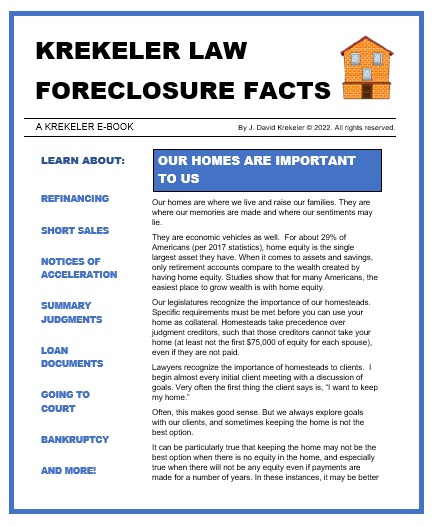Here’s what you need to know about reaffirmed debts and bankruptcy:
If you reaffirm one or more debts in your bankruptcy case, those obligations remain binding and enforceable according to the terms of the reaffirmation agreement. Your failure to comply with the agreement could lead to actions being taken by the creditor.
Most reaffirmed debts are secured by either a home or a vehicle. People are willing to remain obligated on these sorts of debts because they want or need to keep the collateral, whether it’s their home or their means of transportation.
DEALING WITH DEFAULT
Sometimes after bankruptcy these reaffirmed debts go into default. Because the debt survived the bankruptcy discharge and remains enforceable, it is important to deal with the default as soon as possible. Early intervention and communication can sometimes help avoid more serious problems.
If those problems cannot be worked out amicably, the creditor may take action. The action taken will likely depend upon the amount owed, the type of collateral, the value of the collateral, and the options available to the creditor. We would want all of this information to help you deal with the default.
We would also review the reaffirmation agreement itself, and the date and manner in which it was filed with the court. Reaffirmation agreements are highly technical, and are required to contain certain mandatory language in order to be enforceable. They must also be filed with the court appropriately, and within strict time limits. Any failure to comply with all of these conditions may render the agreement unenforceable.
How you deal with a default will depend on the factors described above. If you have equity in the asset but cannot afford the payments any longer, you can sell the asset to pay the debt, while pocketing the equity. If you have no equity in the asset which serves as collateral, you may be able to negotiate a voluntary surrender with the creditor, hopefully including a waiver of any deficiency which may be owed after liquidation of the collateral.
We usually try to take this surrender one step further for our clients. We try to get a cash payment from the creditor in return for the voluntary surrender. This approach works best when the asset has a higher value and when it will take the creditor a significant amount of time, effort, or expense to get possession of and liquidate the asset. When we are talking about homes, we often call this our “cash for keys” approach.
KEEPING THE ASSET
Most people still want to keep the collateral, though. It was important enough to them at the time of their bankruptcy that they reaffirmed the debt. Usually, the asset still carries that importance.
If retention of the asset cannot be negotiated, another bankruptcy may be in order and beneficial.
Let us take a look at these various factors:
- Equity – You certainly do not want to surrender to the creditor an asset with substantial equity, or probably any equity. It would be better to simply sell the asset, pay the creditor, and pocket that equity.
This is not universally true. If the sale of the asset will result in capital gain and income taxes for you, you may be better off getting as little as possible for the asset. I know this is counter-intuitive, and I sometimes have a difficult time explaining to my clients why they want to sell an asset for the least possible price rather than the most. But if all of the sale proceeds will be going to a creditor, and all you are left with is the tax, you are better off selling for less and reducing the taxes owed. Tax consequences must always be considered.
The more equity you have in a property the more likely you are to want to keep it. Many people file bankruptcy to keep homes or other real estate they own for the sole purpose of protecting the equity in that asset.
- Appreciation/Depreciation – If an asset is appreciating or likely to do so, you have more incentive to keep it. This is most likely when we are talking about homes or other real estate. On the other hand, if the asset is depreciating, you have less incentive to keep it when you are in default. Vehicles and equipment usually fall into this category.

Currently, even though were are in what is typical a slow time of the year for real estate, the housing market is still doing well. If you are in default on a home mortgage, you may want to carefully consider all your options for keeping that home even if doing so is difficult for you financially. Your home’s value may go up in value substantially this year.
- Cost – No matter how much property is appreciating or how much you would like to keep it, you might not be able to do so if the cost is unbearable. You may love your Cadillac Escalade, but if the payment is $1,000 per month and you are unemployed, even a bankruptcy may not reduce the payment enough to keep it. The cost of retention of an asset must always be considered.
- Options – You almost always have options. It is important to consider what other alternatives you may have when it comes to retaining a particular asset. With a vehicle, you may be able to buy a replacement. You may be able to lease. You may even be able to borrow a vehicle from your mother at little or no cost. You may be able to file a Chapter 13 bankruptcy and reduce the interest rate and payment to an amount you can afford.
With a home you also have options. Under Wisconsin law, the foreclosure of a home will take quite a lengthy time. This means you can stop making your payments and see how your financial situation changes.
But you have other options as well, instead of keeping this home, perhaps you could downsize. You could rent. Perhaps you could even find housing where you perform services for a landlord in return for free rent. Maybe you have a relative who could offer you housing at reduced or free rent.
There are always options to consider and they should always be considered.

